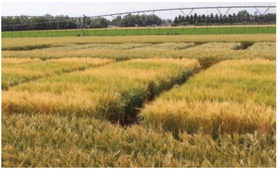Nursery


with a small annual increase in sugar concentration — both critical metrics. He also led a project funded by a USDA Western Sustainable Research and Education grant to study the feasibility of no-till planting for sugar beets. The project showed that no-till led to similar yield and sucrose concentration but cost less compared to conventional tillage.
While sugar beets remain an important crop in the region, the closure of a large local beet processing facility in 2023 changed regional needs, and EARC research adapted. As producers have begun growing more soybeans, dry beans, canola and corn, EARC scientists are testing to select adaptable, high-yielding varieties for the region, as well as studying optimal fertility management strategies.
“With the crop species and production systems shifting from sugar beet to other alternative crops, new agronomic technology, including cultivar selection, seeding date and rate, fertility, weed and disease management needs to be developed,” said Chen.
When it comes to dryland research, Chen and William Franck, the research scientist at EARC, continue to lead the statewide pulse crop variety testing program. They collaborate with plant breeders and other research centers at MSU, North Dakota State University, the USDA and private companies to test pea, lentil and chickpea varieties across Montana. Chen said the work has led to the release of several new crop varieties and contributed to pulse crops’ expansion in Montana — increasing from less than 50,000 acres harvested annually two decades ago to leading the nation with over 1 million acres.
Chen’s team also conducts variety trials for wheat, barley and durum at the research center and on farmers’ fields in four eastern Montana counties.
“Testing new crop species and varieties is important for innovation, but adapting and establishing a new crop industry takes a persistent and longterm effort,” he said.
Chen is also exploring another frontier of crop research with a project funded by the U.S. Department of Energy. Led by Chaofu Lu in the College of Agriculture’s Department of Plant Sciences and Plant Pathology, the project is examining camelina’s potential as a source of oil for industrial and bioenergy uses.
EARC serves more than 30,000 square miles of Montana, and producers around the region have long been its partners, volunteering test plots on their own land for research projects. Some of the partnerships have been going strong for 40 years or more, said Chen, allowing EARC to test new crops and varieties in various environments for adaptation and performance.
The center is also home to a unique plant pathology research program led by associate professor Frankie Crutcher, who conducts both molecular and field-scale research on various plant diseases.
One such disease, Fusarium head blight, also known as wheat scab, is affecting cereal crops nationwide. It’s a high-priority target for research because of its potentially disastrous impacts on yield, said Crutcher. Because of ongoing work at EARC in collaboration with MSU’s wheat breeding program, Montana’s first spring wheat variety with some demonstrated scab resistance was released in 2021, named MT Sidney for EARC’s hometown, followed by a second variety that showed some resistance, MT Dutton.
“Although developing resistant varieties is an incredibly important part of what we do, it can’t replace the outreach component of our program,” said Crutcher. “Effective management of Fusarium head blight starts before the crop is even in the ground, and educating farmers on an integrated approach has been a major focus since I started at the EARC in 2016.”
Nearly 175,000 acres of chickpeas were planted in Montana in 2023, and the primary limiting factor in chickpea yield is a disease called Ascochyta blight, said Crutcher. EARC scientists are doing laboratory research on disease resistance in chickpeas while studying a possible management technique for reducing the disease: growing chickpeas alongside another crop, a practice called intercropping. They are examining the effects of growing chickpeas and flax together to reduce the number of fungicide applications needed and decrease disease pressure on chickpea plants. The project, supported by the Western Sustainable Agricultural Research and Education Program, may provide an immediate option for producers, particularly those in organic systems, until resistant chickpea varieties can be developed.
EARC has a 12-person staff and, like all seven of MSU’s research centers, is overseen by an advisory committee of local producers, industrial representatives and MSU Extension agents.
“I am so grateful for the strong support from local communities, businesses and producers to EARC,” said Chen. “The EARC office building and greenhouse was built with support from local businesses and the public, and every year local businesses sponsor our field day. The staff of EARC are honored to work here to serve producers and the public in the region.”
A spring wheat, barley and durum wheat nursery at MSU’s Eastern Agricultural Research Center. (Image courtesy of Chengci Chen)


